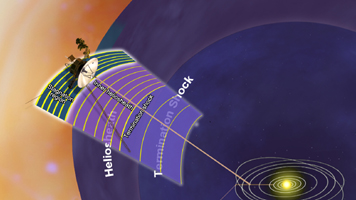
Figure 1
Click on the image for larger viewThis artist's concept shows NASA's Voyager 1 spacecraft in a new region at the edge of our solar system where the magnetic field lines generated by our sun are piling up and intensifying. Voyager 1 is in an area scientists are calling the stagnation region, at the outer layer of the heliosphere, or magnetic bubble that the sun blows around itself. Magnetic field lines form a spiral around the solar system because of the rotation of the sun (see PIA15179) and at the edge of the solar system, they form roughly parallel lines. Since the end of 2004, when Voyager 1 passed the termination shock, where the solar wind dramatically slows down and becomes turbulent, the intensity of the magnetic field tripled, as the distance between magnetic field lines decreased by one-third. Since entering the new region in mid-2004, the magnetic field intensity increased twice more as the distance between magnetic field lines decreased again by about half. Scientists believe the field lines are piling up because something outside is pushing back.
One view shows a simple schematic. Another view lays the schematic on an artist's concept of the heliosphere and its outer layer.
The Voyager spacecraft were built by NASA's Jet Propulsion Laboratory in Pasadena, Calif., which continues to operate both. JPL is a division of the California Institute of Technology. The Voyager missions are a part of the NASA Heliophysics System Observatory, sponsored by the Heliophysics Division of the Science Mission Directorate in Washington. For more information about the Voyager spacecraft, visit http://www.nasa.gov/voyager.

